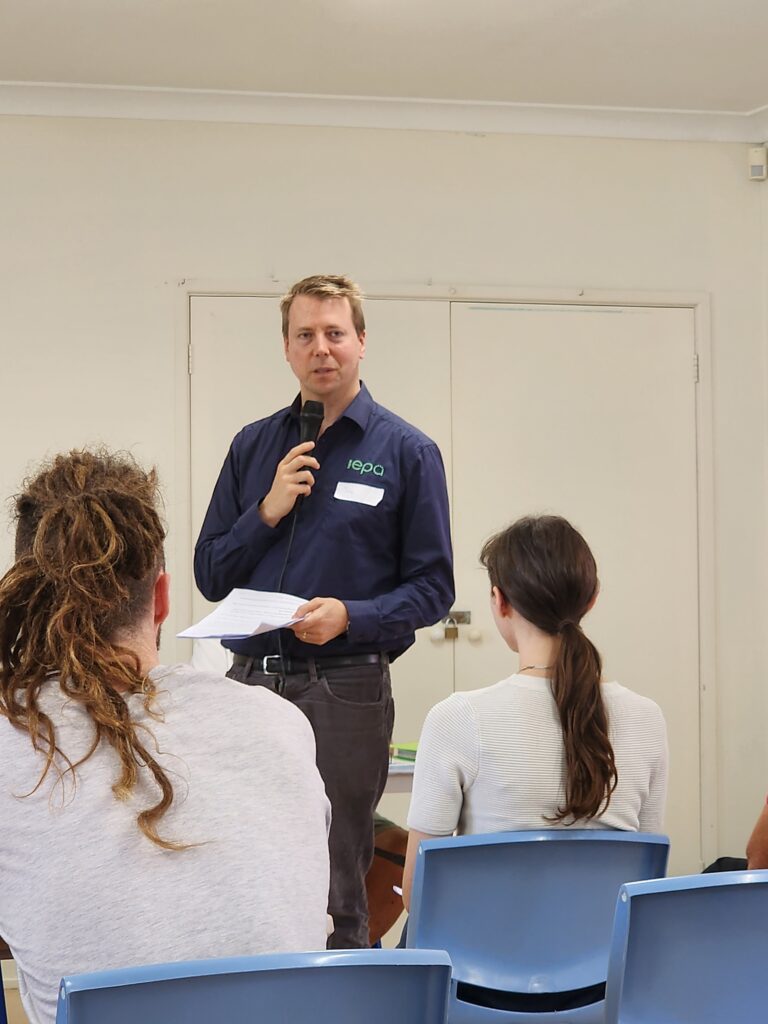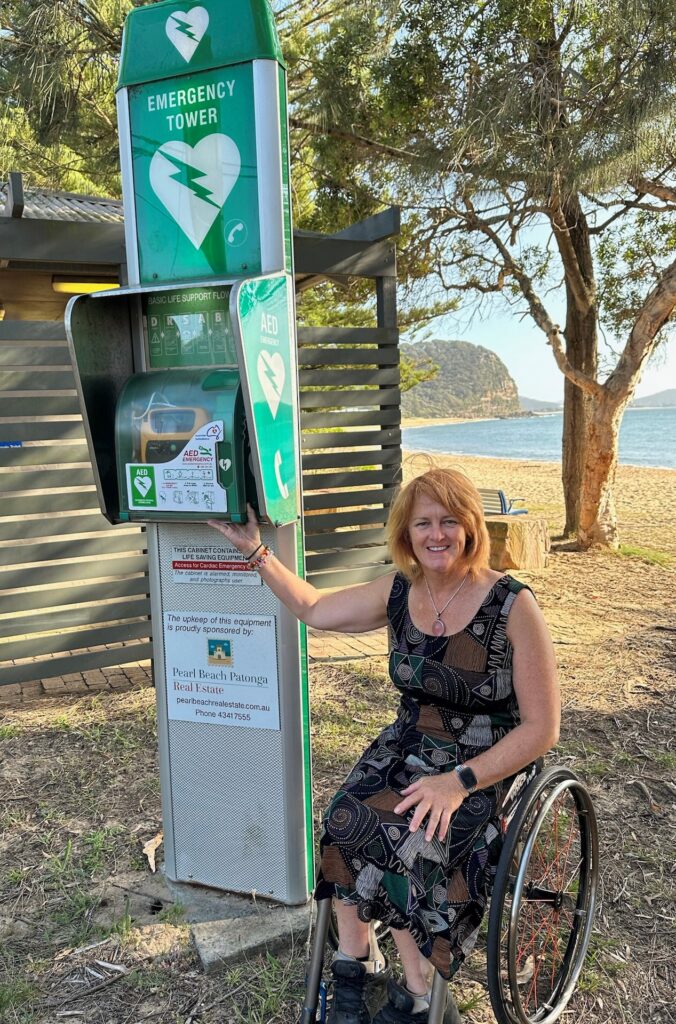The CEO of the NSW Environmental Protection Agency, Tony Chapel, used the occasion of a community meeting at Chain Valley Bay to announce the installation of 20 additional air monitors in the region and to assure the community that the EPA is listening to its concerns.

By Jacquelene Pearson
Tony Chapel looks almost too youthful to be the CEO of a major state regulator such as the NSW Environmental Protection Agency, but he appears to be wise enough to understand that the communities living around the Vales Point and Eraring coal-fired power stations cannot be ignored for much longer.
“We talk about stewardship and that requires us to stand in the shoes of community,” was one of Chapel’s opening remarks when he stood to address Future Sooner’s community meeting at the Chain Valley Bay community centre on Friday, 1 December.
“As a regulator, and part of government, we can only do our best work when civil society is our partner. The community’s voice is important,” Chapel said.
He noted that the NSW Government was “very committed” to the journey to decarbonize the state’s economy, as demonstrated by its adoption of the Net Zero Future Act which made the minister legally responsible for achieving a 50 per cent emissions reduction by 2030, 70 per cent by 2035 and reach zero by 2050.
He praised the government for establishing the Net Zero Commission.
“The EPA is really excited by this development because it gives us a partner with independent rigor. It enables a ratchet mechanism that can’t go backwards. The government and minister can set an earlier target but not a later one, a higher one but not lower,” Chapel said.
Coal ash
The EPA Chief acknowledged the community’s concerns about the “management of coal ash”.
According to Chapel, three of the six recommendations from the NSW parliamentary inquiry that looked at the management of coal ash, “are now completely implemented – real time availability of data, dam safety, and power station requirements to report on the production, storage and use of coal ash.
The other three recommendations are still underway, he said.
“We’ve got a team of experts currently modelling water and sediment quality,” he said, undertaking to release that modelling once it had been peer reviewed but did not provide a timeframe for that release.
“We are also overseeing the five other recommendations that other parts of the government are working on,” he said, adding that dam safety information is now published online.
Infrastructure NSW, according to Chapel, is looking at more ways to use coal ash in their procurement.
Mr Chapel said he was very pleased to gazette the first intention to prepare a Protection of Environment Policy or PEP, that relates to the mandatory recycling of coal ash and looks at how it is used in infrastructure.
He said that PEP would “essentially require any proponent to be looking at coal ash as part of their recycled content.
“In terms of the other recommendations, I know we are working closely with a group called the Ash Development Association,” he said, adding that there would be a Carbon Recycling and Abatement fund to look at projects for coal ash reuse.
“My transport colleagues tell me by the end of this month they will have finalised new procurement guidelines,” he said. “Having those guidelines recalibrated is really important.”
Mr Chapel did acknowledge that there was “more to do about managing impacts of some of the legacy sites and those that have some time to operate yet.
“The coal power stations do produce emissions and they impact all of Sydney including the local community. The advice we receive from the Department of Health is the air quality doesn’t have an impact based on location. It has as big an impact in Sydney as closer to the coal power stations.
“All of these power stations will close. It is really a question of how quickly we can get the zero carbon infrastructure in place.
“The NSW Government has an extremely ambitious agenda.
“We can all look forward to the day that infrastructure is operating and we have a zero carbon position.”
Clean air
Mr Chapel told the community meeting that the emissions exemptions granted to the Vales Point power station for two years were necessary because power station are now forced to “ramp” to deal with fluctuations in the use of solar energy and other renewables.
“That changes the way the emission profiles work and required studies to look at how to manage [the fluctuations].”
According to Mr Chapel, Vales Point is now “Fully compliant with the regulation”.
He acknowledged that public confidence was a priority for the EPA.
He said his goal was “To move to real time monitoring solutions that give individual and community members confidence of their environmental quality data.”
Mr Chapel announced that the EPA had “switched on 20 additional air monitors in this region, to measure particulates, called purple air monitors. Our hope is you will find that a valuable resource
“You will be able to see in real time the presence or absence of dust,” which he said would be important “because we are coming into a dry cycle”.
Water quality
In terms of the impacts from the power stations on water quality in Lake Macquarie, Mr Chapel said there had been a “step change from what we had a year ago.
“Whether it is the review of the power stations themselves or other issues, the EPA is always available to hear feedback and take on submissions
“We expect to release early next week if not today a new air quality study of the air shared after the Liddell Power station closed,” he said.
The study revealed that the amount of Nitrous Oxide (NoX) in the air declined by 22 tonnes per day – the equivalent of taking over 100,000 cars off the road.
Mr Chapel acknowledged and congratulated Future Sooner on receiving the Environmental Justice Australia award.
He said the EPA had received about 100 submissions in response to the recent five-year review of the power station Environmental Protection Licences.
Problems restated
Future Sooner’s Dr Ian Charlton introduced Mr Chapel at the community meeting, noting that the region reported an additional 600 cases of childhood asthma per year as a consequence of the air pollution generated by the power stations.
“International research highlights that power stations produce smoke and smoke is a problem for us all. The chimney stacks providing passive smoke not only in the surrounds but to the whole Sydney basin s we have between 5-6 million people passively smoking.
“Once you know this stuff you feel obliged to act on it. You just can’t sit on your hands and do nothing.
“Ash dams are almost as big a problem. Unfortunately when you get a lump of coal this big and burn it, it shrinks down and leaves leftovers which don’t burn,” Dr Charlton explained.
What’s left is coal ash made up substantially of heavy metals.
“I don’t think there was actually a plan for the ash dams. They thought what are we going to do with this ash. And it was just dumped locally.”
Multiple community advocates spoke at the meeting in response to Mr Chapel and The Point will report on those presentations in the coming days.
Enjoy this article? Explore more of our ESG News below:
Environmental Justice News | Social Justice News | Good Governance News | Climate Change News | ESG Investing News | Housing News | Renewable Energy News | Breaking Central Coast News
Prefer your news delivered to your email inbox?
Click here to subscribe to our free weekly newsletter to stay up-to-date with local, national and global ESG news.


